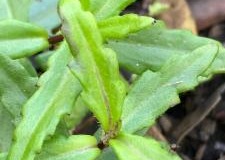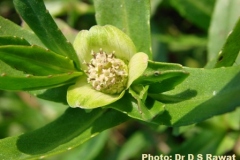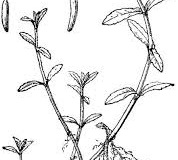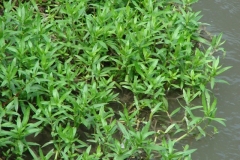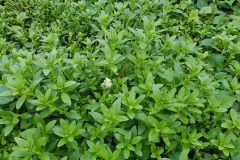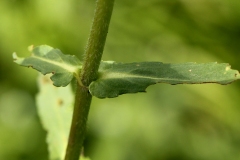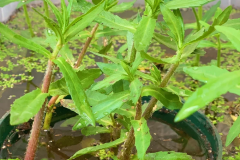
| Buffalo spinach Quick Facts | |
|---|---|
| Name: | Buffalo spinach |
| Scientific Name: | Enydra fluctuans |
| Origin | Indo-Chinese origin, occurring in tropical Asia and Africa |
| Colors | Blackish colored |
| Shapes | Small, oblong-shaped seed called an achene about 3 millimeters long |
| Taste | Bitter |
| Health benefits | Cures Skin Disease, Treats Acidity and liver Problems, Treat Sleeplessness, Treats Neurological Disorders, For Weight loss, Treats Anorexia, Controls Low Blood Pressure, Low in calories, Improves digestive health, Boosts immunity, Regulates blood sugar levels, Promotes healthy bones, Reduces inflammation |
| Name | Buffalo spinach |
|---|---|
| Scientific Name | Enydra fluctuans |
| Native | Indo-Chinese origin, occurring in tropical Asia and Africa. It is common in all countries of South-East Asia, wild and sometimes cultivated |
| Common Names | Buffalo Spinach, Marsh herb, Water cress |
| Name in Other Languages | Assamese: Helonchi (হেলোংচি), Helchi (হেক্চী), helech Bengali : Hingcha, Helencha, Hinchashak, Harhach, Helchi (হেল্চী), Helonchi (হেলোংচী) Bodo: Elashi moigong Cambodia: Kanting ring Chinese: Zhao ju (沼菊) English : Buffalo spinach, Marsh herb Hindi: Harkuch (हरकुच), Haruch (हरुच), Matsayaakshi (मत्स्याक्षी), Alangshi, Helencha, Harkuch Indonesia: Godobos, kokoha, ambur Kinyarwanda: Bugangabukari Laos: Bungz ping Malay: Godobos, Chengkeru Malaysia: Chengkeru, kangkong kerbau Manipuri: Komprek tujombi, Phak bungrum Oriya: Hidimicha Philippines: Kangkong kalabaw Sanskrit: Matsayaakshi (मत्स्याक्षी), Hilamochika, achari, bramhi, chakrangi, helanchi, hilamochika, himamocika, jalabramhi, mambi, matsyakshi, matsyangi, mochi, rochi, sasasrutih, shankhadhara, trinittaparni, vishaghni Spanish: Enhidra Thai: Phak bung ruem (ผักบุ้งร้วม), phakbung-pling, phakpaeng Vietnamese : Cây rau ngổ, Rau ngổ, Ngổ trâu, Ngổ đất, Ngổ hương, rau ngổ trâu, rau ngổ thơm |
| Plant Growth Habit | Prostrate, spreading, annual or perennial, herbaceous edible tropical herb |
| Growing Climates | Along ditches, swamps, water courses, aquatic areas, margins of fish ponds, rice fields, marshes and stream sides |
| Plant Size | 30 – 80 cm tall |
| Stem | Somewhat fleshy, cylindrical 30 centimeters or more in length and 0.5-1 cm in diameter, hollow, somewhat hairy, sparsely branched, rooting at the lower nodes |
| Leaf | Stalk less, linear-oblong, 3 to 5 centimeters in length, pointed or blunt at the tip, usually truncate at the base, and somewhat toothed at the margins. |
| Flowering season | November-April |
| Flower | Flowering heads are without stalks, borne singly in the axils of the leaves, and excluding the bracts, are less than 1 centimeter in diameter. Outer pair of the involucral bracts is ovate and 1 to 1.2 centimeters long; the inner pair is somewhat smaller. Flowers are white or greenish-white. |
| Fruit Shape & Size | Small, oblong-shaped seed called an achene about 3 millimeters long |
| Fruit Color | Blackish colored |
| Taste | Bitter |
| Plant Parts Used | Leaves, young plant parts |
| Health Benefits |
|
| Other Facts |
|
| Precautions |
|
Plant Description
Buffalo Spinach is a leafy plant that grows slowly and spreads. It can be an annual or a perennial. It usually grows to be between 30 and 80 cm tall. The plant usually grows near water, like in ditches, swamps, streams, rice fields, marshes, and the edges of fish ponds. The plant’s branches are hollow, cylindrical, and a bit fleshy. They have a diameter of 0.5 to 1 cm and are at least 30 cm long. They have few branches, and the bottom nodes are where roots grow. The plant has opposite leaves that are closely oblong or linear-oblong in shape and almost don’t have stalks. Most of the time, they are 2–6 cm long and 4–14 mm wide, with a broad, truncate or subcordate base and a narrow, angled tip. Most of the time, the edges are serrated and toothed, and the leaves have small glands on both sides and a blunt or pointy tip.
Flowers & Fruits
Small flower heads that don’t have stems grow in the spaces between the leaves. If you leave out the sepals, the flower heads are less than 1 centimeter across. The outer pair of bracts that circle the flower are oval and about 1 to 1.2 centimeters long. The inner pair is slightly smaller. The flowers are usually white or white with a greenish tint, and they bloom from November to April. When the pollen gets to the flowers, they make a small, oblong-shaped seed called an achene. The achene is about 3 millimeters long, and its surface is smooth. It has a thickened palea around it that works as a floater. The achene is blackish and does not have a pappus.
Health benefits of Buffalo Spinach
Buffalo spinach is a very healthy and versatile green that can help you in many ways. If you eat Buffalo spinach, it can help improve your gut health, boost your immune system, and help keep your bones healthy. By adding Buffalo spinach to your meals, you can improve your health and general sense of well-being.
1. Cures Skin Disease
People think that buffalo spinach can help keep skin problems at bay. This plant has a number of chemicals that kill bacteria that can help the body fight off skin-problem-causing bacteria. Also, it can help get rid of dangerous toxins in the blood that can cause skin problems. Using Buffalo spinach may help make skin problems like acne, skin allergies, pimples, and blisters less likely to happen. Adding this plant to your diet may also help your skin look better.
2. Treats Acidity and liver Problems
People think that the ingredients in buffalo spinach can help treat acidity and other problems with the liver. If you eat soup made from Buffalo spinach, it may help with acidity, gastritis, inflammation of the heart, and heartburn. It may also be good for your liver and intestines.
3. Treat Sleeplessness
Buffalo spinach is a natural way to treat sleepiness that changes the game. This super food is full of nutrients that help reduce stress by regulating the release of stress hormones and calming muscles. By doing this, it provides a safe and natural way to treat sleep problems and help people get a good night’s sleep. So, if you’re tired of counting sheep and taking pills to get to sleep, try buffalo spinach and see for yourself how it can change your life. Say goodbye to sleepless nights and hello to sweet dreams!
4. Treats Neurological Disorders
Enhydra Fluctuans is a very useful herb for healing problems with the nerves. This amazing plant has been shown to be effective against a number of diseases and conditions that come from this problem, including Alzheimer’s disease. Enhydra Fluctuans is a safe and natural way to improve nerve function and improve general health. It does this by using its powerful properties. So, if you’re looking for a natural way to help you deal with nervous dysfunction and other problems related to it, give Enhydra Fluctuans a try and see what it can do for you.
5. For Weight loss
If you’re trying to lose weight, you might want to try this herbal plant. Not only can it help you lose weight, but it also has a lot of other benefits that are good for your body. This plant is a great source of important nutrients that your body needs to stay healthy. It is full of protein and antioxidants. So, if you want to lose weight and are looking for a natural and effective way to help, adding this plant to your diet plan could be just what you need. Try it out and see for yourself how it works.
6. Treats Anorexia
Anorexia nervosa is a unique neurological disease that causes people to lose weight in a way that isn’t normal. It is caused by a lack of interest in proper nutrition that lasts for a long time. This situation can hurt both the body and the mind, making it hard to eat enough. Buffalo spinach, on the other hand, is a natural remedy that can help ease the symptoms of this disease. Buffalo spinach can help the body get the nutrients it needs again because it is full of important nutrients that speed up the metabolism and increase hunger. So, if you or someone you know is suffering with anorexia, try adding buffalo spinach to your diet and see for yourself how it helps.
7. Controls Low Blood Pressure
If you have low blood pressure, eating wild spinach could help relieve some of your symptoms. You can easily control your blood pressure by taking 2 teaspoons of juice combined with the similar quantity of honey and kalmau leaf juice each morning for a month. This powerful mix of natural ingredients helps your blood move well and keeps your blood pressure in a healthy range. So, if you want a natural and effective way to control your low blood pressure, try adding buffalo spinach to your daily routine and see the results for yourself.
8. Low in calories
Want to lose weight or keep your weight at a healthy level? Buffalo spinach could be just what you need to add to your diet. It tastes great and has few calories, which makes it a great choice for people who want to stay fit and healthy. This leafy green is full of vitamins and nutrients, like iron, calcium, and vitamin C that are important for keeping your body fit. Also, it has a lot of fiber, which makes you feel full and happy for longer. So, whether you’re trying to lose weight or just want to live a healthy life, you should try buffalo spinach.
9. Improves digestive health
If you want to improve your gut and keep from getting constipated, adding buffalo spinach to your diet might be the answer. This leafy green has few calories and is full of important vitamins and minerals. It’s also a great source of fiber. Because it has a lot of fiber, buffalo spinach can help keep your digestive system working well by keeping you regular and stopping you from getting constipated. So, if you have digestive problems, try adding buffalo spinach to your meals as a tasty and healthy way to help your gut health.
10. Boosts immunity
Enydra fluctuans can help you get the best health and happiness possible. This natural wonder can help your body fight off infections and diseases by making your immune system stronger. This will make you feel strong and healthy. By adding Enydra fluctuans to your daily routine, you can take care of your health and enjoy life to the best. Don’t miss out on the amazing health benefits of this amazing plant. Add Enydra fluctuans to your daily health habit today.
11. Regulates blood sugar levels
If you want to keep your blood sugar levels in check and eat something tasty and healthy, wild spinach is the way to go. This superfood is full of chemicals that have been shown to help control blood sugar. This makes it a great choice for people who have diabetes or are worried about getting it. Buffalo spinach is not only a tasty addition to any meal, but it also helps your digestive system and boosts your defense system, among other things.
12. Promotes healthy bones
Want a natural way to keep your bones strong and stop osteoporosis? Buffalo spinach is what you need. This leafy green is a great addition to any diet because it has a lot of calcium and vitamin K in it. Calcium is known for helping to make bones strong, and vitamin K helps to keep calcium in the bones where it goes. Together, these nutrients keep your bones healthy and strong, which lower your risk of breaking a bone or having other problems with your bones.
13. Reduces inflammation
Want a natural way to reduce inflammation and avoid chronic diseases? You might want to eat some wild spinach. This leafy green is full of chemicals that have been shown to be very good at fighting inflammation. By lowering inflammation in the body, buffalo spinach can help prevent heart disease, cancer, diabetes, and other long-term illnesses. Buffalo spinach is not only a tasty addition to any meal, but it also has a lot of health benefits, such as making digestion easier and giving your immune system a boost.
Traditional uses and benefits of Buffalo Spinach
- In the Philippines, people use pressed leaves as a remedy for herpetic skin eruptions by applying them directly to the affected area of the skin.
- Malays use the young parts and bitter leaves of a plant as a laxative.
- The use of leaves is beneficial for treating skin and nervous system disorders.
- Fresh juice extracted from leaves is often used to treat neuralgia and other nervous system disorders.
- Indian medicine utilizes it for treating different skin conditions and as a natural remedy for constipation.
- In the Indian state of Assam, plant extracts are employed as a treatment for skin conditions, nervous system disorders, and hypertension.
- The juice extracted from the leaves is applied as a soothing agent for gonorrhea cases, often in combination with cow’s or goat’s milk.
- Crush the leaves into a paste and then apply it cold to the head.
- Plant is utilized to treat sluggishness of the liver. An infusion is made the night before, then boiled with rice and consumed with mustard oil and salt.
- The Marakh sect of the Garo tribe in Bangladesh uses a particular remedy to treat diabetes.
- Ayurveda uses this particular remedy for the treatment of liver disorders, skin disorders, and nervous disorders.
- The decoction of the plant is utilized in the treatment of urinary problems, diarrhea, and dysentery.
- Freshly extracted juice from plants is administered orally as a treatment for skin diseases.
- To improve liver functions, a plant is boiled in water along with rice gruel.
- The entire plant is utilized to treat constipation.
- Finely crushed above-ground parts of the plant are used to treat pimples when applied topically.
- The Meitei-pangal community in Thoubal district of Manipur cuts the plant into pieces at the nodes and boils it in water to make an extract. This extract is then used for the treatment of diabetes.
- One way to treat kidney stones is by boiling plant leaves and drinking the resulting liquid mixed with sugar.
- Slightly bitter leaves are used to treat inflammation, skin diseases, and smallpox.
- It is used to deal with numerous disorders comprising bronchitis, nerve diseases, constipation, skin problems, joint pain, asthma, and swelling in the hands and feet.
- Ayurvedic doctors recommend the use of certain herbal plants to reduce skin problems or the risk of diseases and to maintain healthy skin.
- Regular consumption of this herb may increase the amount of hemoglobin levels in the blood.
- It is also frequently applied to the breasts of females to control inflammation.
- In many rural areas, it is used to cure gonorrhea.
- In the Cachar district of Assam, the stem of a certain plant is used for treating gastric issues and ulcers, while the entire plant is used to treat constipation.
- The plant known locally as Helechi is considered a folk medicine by some populations in the Dibrugarh district. The aerial parts of the plant are crushed into a fine paste and applied over pimples as a remedy.
- In the Thoubal district of Manipur, the plant known as Komprek tujombi is used by the Meitei-pangal community to treat diabetes.
- Muslim herbalists in the same region also use the whole plant to treat kidney stones. They boil the leaves and drink the resulting liquid mixed with sugar in a prescribed ratio.
- In Meghalaya, the Jaintia tribe refers to this plant as Kynbat hingcha and utilizes the juice of its leaves for both skin diseases and as a laxative. They also prescribe it orally for liver diseases.
Ayurvedic health benefits of Buffalo Spinach
- Skin problems: To alleviate skin problems caused by sweat, you can try applying diluted buffalo spinach juice to the affected area. Simply mix a small amount of water with the juice before applying it to your skin.
- White patches: If you’re looking to get rid of white patches on your tongue, try consuming warm Enhydra Fluctuans juice for a few days. This may help to alleviate the condition.
- Itching: If you experience itching during the autumn and rainy seasons, you can try consuming a mixture of 2 teaspoons of plant juice and raw milk. It may help alleviate the itching.
- Gonorrhea: Daily consumption of a mixture of 30 ml plant juice and 50 ml goat or cow milk might help regularize bile making. This procedure may be helpful for persons with Gonorrhea.
- Lower abdominal pain/cramp: If you experience lower abdominal pain/cramps or other nerve problems, consuming Enhydra Fluctuans juice on a regular basis may provide relief for your condition.
- Headache: To alleviate a headache, try applying a paste or poultice of Enhydra Fluctuans to your forehead. This may help to provide relief from your headache.
- Lumps: If you notice 2-3 lumps in your body, you can try consuming a blend of 2 grams of sandalwood powder and half a cup of leaf juice in first stage. This might help ease the lumps.
- Kidney Stones: To treat kidney stones, Buffalo spinach leaf juice can be consumed with sugar. This combination may be helpful in alleviating the condition.
- Constipation: The whole Matsyakshi plant is used as a medicinal remedy for treating constipation.
- Blood Purify: A juice made by extracting the juice from plant leaves and stems, which is then mixed with sugar, is recommended to be consumed once a day on an empty stomach with a serving size of 20 ml, in order to purify the blood.
- Liver disorders: A decoction is made from plant leaves and stems, along with salt, to produce a 50ml amount. After adding mustard oil, it is recommended to take 4-5 drops twice a day for three weeks in order to treat liver disorders.
- Diarrhea: The juice extracted from the leaves and stems of plants is used to treat diarrhea. It should be taken three times a day, with 10 milliliters of juice consumed each time.
Culinary Uses
- Leaves and roots that have been boiled can be eaten with rice.
- Southeast Asia, especially Indo-China and Thailand, uses all of the plant’s green parts, especially the young shoots, as a veggie or seasoning. You can eat them raw or steam them.
- The plant is a bit bitter and makes you go to the bathroom, which may be part of why it can be used as medicine.
- You can eat the roots and leaves raw or cooked.
- The plant can be used in salads, as a vegetable, or to add taste.
- In Bengal, it is washed, chopped, cooked as a Sag fry, or boiled with rice and eaten with boiled potatoes, salt, and mustard oil.
- In Malaya and other places, the young parts of the plant are eaten as a salad.
- They are sometimes cooked before they are eaten.
References:
https://gd.eppo.int/taxon/ENYFL
http://www.stuartxchange.com/Kankong-kalabau
https://uses.plantnet-project.org/en/Enydra_fluctuans_(PROSEA)#Synonyms
http://www.theplantlist.org/tpl1.1/record/gcc-134747
http://www.flowersofindia.net/catalog/slides/Buffalo%20Spinach.html
https://tropical.theferns.info/viewtropical.php?id=Enydra+fluctuans
https://plants.usda.gov/home/plantProfile?symbol=ENFL


